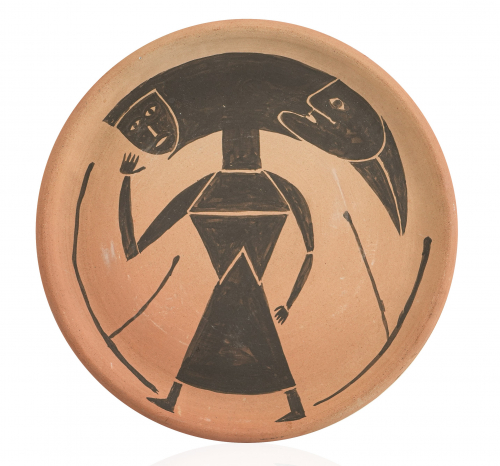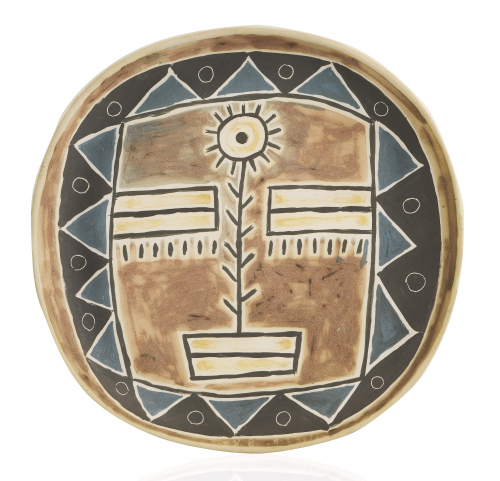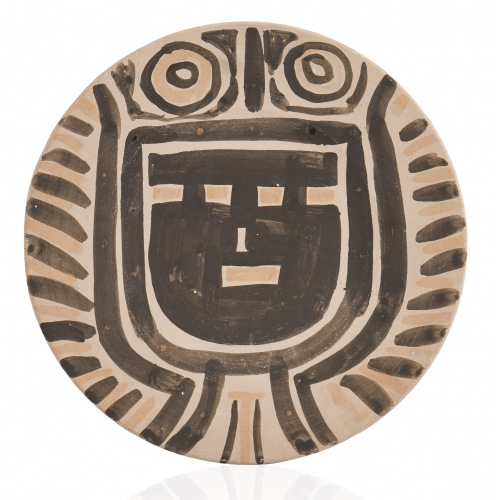
The experience of the Madoura workshop in Vallauris
The ceramics painted by Victor Brauner in the 1950s
In the spring of 1953, Victor Brauner was in Golfe-Juan, staying at the Hôtel du Golfe.
Through Jacqueline Lamba, Brauner met Picasso, who had already discovered new possibilities of expression around ceramics in Suzanne and Georges Ramié's workshop in Vallauris. The Madoura workshop thus began to produce, in small series, a wide variety of pieces in terracotta decorated by Picasso, who seemed to take great pleasure in practicing on this new creative terrain.
He led Victor Brauner to follow in his footsteps to discover the potential of painting on clay.
Vallauris has a long tradition of ceramics. The important Massier workshop, active since the eighteenth century, was established there, like others, primarily because of the quality of the clay found nearby. Under the impetus of Delphin and Clément Massier, at the beginning of the 20th century, the company began to produce artistic pieces of international renown which supplanted the simple handmade culinary pottery. However, the economic recession of the 1930s put a stop to the prosperity of this company.
Vallauris will have the opportunity to distinguish itself again on the international artistic scene through the Madoura workshop, especially thanks to Picasso, who also brings in his wake in the Ramié workshop several painters such as Marc Chagall, Henri Matisse or Victor Brauner.
In the wake of Pablo Picasso in Vallauris
Picasso's influence is palpable in these pieces, but how could Brauner, so attentive to external events, to the conditions of reality, which he knew how to transfigure in his paintings, like a magician, have failed to discover what was substantially universal and human in Picasso's genius? If he considered him a "great man", it was probably largely for the certainty of his achievements and also for the intelligence of his language: a powerful and unique voice, which hums a heady and highly significant mythology, anchored in a universal past, an expression whose force inevitably surpasses him.
Whatever the formal difference in approach, Brauner probably did not feel alienated from this mystery.
When he, in turn, took up the pottery of Vallauris, the surviving examples tell us that he seems to have preferred to paint on more sober dishes or plates. These pieces are however quite different in size, thickness, the finish of the clay that composes them, thus varying the supports of the experiment.
A concern for symmetry, which runs through all of Brauner's pictorial work, is reflected here in the motifs chosen to adorn the rounded shapes of the dishes. But it is almost certain that Victor Brauner, painting these utilitarian objects, considered their symbolic dimension more than their decorative value. Like wax, earth is a natural element, which man has always associated with his way of life, with his rituals of all kinds. Modelable at will, the earth is charged with a deep mystique, the culinary ceramics a fortiori.


The modern idea of the sacred in the art of Brauner
Alain Jouffroy evoked to qualify the art of Victor Brauner, "a modern idea of the sacred" (Alain Jouffroy, "A modern revision of the sacred", XXème siècle, n°24, 1964).
These paintings on ceramics are of course not without evoking the Greek vases with black or red figure of the ancient world, which were used for the libations, the banquets or other ceremonies and on the belly of which unfolded mythological decorations which sometimes reached a great complexity.
With the help of simpler and less combined motifs, which seem to borrow from the repertoire of parietal decorations, the drawings of Egyptian hieroglyphs or the art of non-Western civilizations, Victor Brauner also unveils a certain mythology, which sounds like a legacy of surrealism that had kicked him out a few years earlier (for having sided with Matta, Brauner was expelled from the group by André Breton in 1948).
In spite of this eviction, Victor Brauner will continue as he had always done to pay attention to coincidences, signs, premonitions and all the invisible but perceptible mysteries of this life, carrying better than anyone in his work until his death in 1966 the stigmata of the spirit of the surrealists, even in its most intimate contradictions.
See the ceramics of Victor Brauner offered on sale by the gallery on the occasion of BRAFA 2023
